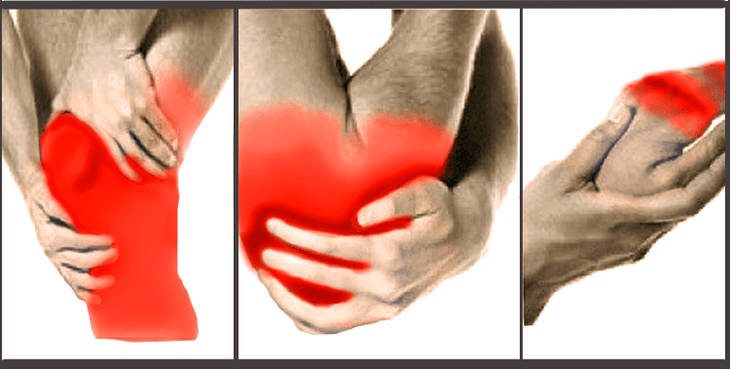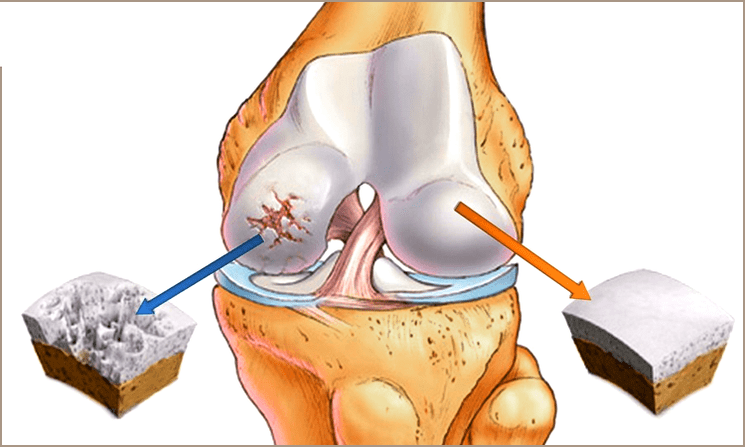What is the difference between arthritis due to arthrosis?You don't just have to know doctors.People are often involved in self -medication and expose themselves to a great risk and take an illness for another.Such a mistake can lead to serious complications.In the article we analyze the differences in the symptoms, the characteristics of treatment and the prevention of pathologies.The knowledge of the symptoms helps to take the necessary measures in good time.With arthritis or osteoarthritis all of our mobile connections at the site of the joint of the bones, cartilage, i.e.H. The joints of the skeleton.Often diseases due to consonant names, but the difference between them is not only the symptoms, but also in the causes of the occurrence, characteristics of the course, details of the therapy.

What is the difference between arthritis and arthrosis: a general concept
In the name there is a common root of "ARTRO", which means Greek, a joint that is exposed to basic diseases.However, arthrosis has no inflammatory nature, the basis is degenerative processes, i.H. The wear and the correct designation of the disease is arthrosis, since bone formations are exposed to changes.
Osteoarthritis is a chronic disease in which the "deleting" of articular surfaces and capsules occurs through which the deformation begins.In advanced cases - complete immobilization of the limb.The changes influence the entire complex bone surfaces, ligaments, meniscus, cartilage, synovial bowl and all the structures nearby.
Pathologies are exposed to older people.The older, the more the prevalence of the disease increases.In rare cases, young people can affect young people with hereditary signs or after an injury.According to statistics, around 10% of the population suffer and the main swell is observed in humans over 65 years (85% of all patients).
On the contrary, arthritis is an acute illness based on inflammation.Often the disease is only a symptom for the underlying disease (rheumatism), but can be the only violation.The neglected steps are transferred to a chronic river.In contrast to arthrosis, young people most often have inflammatory damage.It can manifest after 40 if a person has suffered a severe cold or infection.The prevalence in the world population is only 2%.
Reasons
Due to various etiologies, different causes and factors lead to the occurrence of diseases.In addition, osteoarthritis often occurs against the background of purulent arthritis or rheumatism.
The main factors for arthritis.
- Trauma and surgical joint interventions.
- Congenital dysplasia (underdevelopment) of the joints.
- Dostrophically depth processes.
- Obesity.
- Older age.
- Inheritance.
- Climax.
With this disease, the joints only suffer, while there is a general inflammatory process in arthritis.It is often accompanied by damage to kidneys, hearts and liver.
Different types of diseases are differentiated:
- rheumatoid;
- reactive;
- infectious;
- Gout.
Very often arthritis arises against the background of the transferred influenza, frequent sore throat.Development of tuberculosis, gonorrhea, dysentery and psoriasis is not excluded.
Arthritis rarely influences individual joints, usually a whole group of inflammation is exposed to an inflammation, which depends on the etiology - with rheumatism, small connections from hands and feet suffer with phaliasis - phalanges of the fingers.

Symptoms
Despite similar signs - pain, restriction of movement, deformation, there are a number of symptoms that help differentiate between the name of the disease.
- Pain is a leading sign of osteoarthritis, but do not occur immediately.Initially, this is crispy and cracking the joints, and then pain is associated with pain that increases over the course of progress.They normally appear with physical exertion, change the weather, at night (start of pain - immediately after awakening and try to get out of bed).Arthritis is characterized by constant painful pain that can intensify at night and in the morning.In the case of inflammation, unpleasant symptoms during active movements are often decreased.
- Crystal is a specific sign of osteoarthritis.It has a special sound - dry and rough, is often accompanied by sharp pain.
- Deformation - In the case of degenerative changes, the joints change in the later stages when neighboring bone areas are included in the process.Deformation begins with inflammation in the earliest stages, while they increase size due to swelling.
- Redness, an increase in local temperature - is only characteristic for arthritis, since degenerative diseases are based on the type of aseptic (without infectious) necrosis.
- Restriction of movement - arthrosis "blocks" the joint frequently when a sharp crunch is distributed during movement, followed by a sharp pain and a joint block.Arthritis tends to stiffness, not only in the joints, but also in the entire body.
- General discomfort - inflammation, always runs with a change in the state of the entire organism, there is an increase in body temperature and weakness.
Almost all joints can influence the localization of the symptoms.However, damage to the knee and the hip are more characteristic of degenerative processes.Arthritis tends to include small joints of the arms and legs in inflammation, often symmetrical.
Important: Do not mix the crunch of healthy joints with osteoarthritis.In the first case, it is absolutely painless and are connected to the characteristics of the band apparatus (excessive mobility, weak ligaments).Then crunch is accompanied by severe pain and movement restrictions as with osteoarthritis.
Diagnosis
An important diagnostic criterion is a general blood test.The inflammation of the joints always results in an increase in the ESR (more than 25 mm/h), and leukocytes are still with infectious arthritis.The blood change is not characteristic of osteoarthritis.
Incidentally, there is a special protein that belongs to the class of immunoglobulins and reacts to any damage by any factor in its own cell-one rheumatoid factor with which you can determine the presence of rheumatoid arthritis.C-reactive protein that is a sign of inflammation is also determined.Gout is characterized by an increase in uric acid in the blood, urine.
For both diseases, it is initially necessary not only to pass a blood test, always an X -Ray image of the joint.In arthrosis, there is a narrowing of the gap between the joints, osteophytes (bone growth), deformations and osteoporosis.It is possible to appoint CT and MRI to clarify changes in soft tissues and bone structures.
Osteoarthritis is also characterized by a narrowing of the gap and periartic osteoporosis.However, they appear in the early stages (as with degeneration, such changes only begin in 3 and 4 stages).If the process has an infectious character, seeds are often formed - areas of necrosis that are surrounded by a healthy tissue.Transfer is observed in a chronic course, subluxation of hinge structures.
It is advisable to carry out an ultrasound to determine the presence of a liquid or a pus in the joint bag (most characteristic for arthritis) and diagnostic punctuation - it enables you to identify the pathogen and the type of effusion.
Make sure that general investigations - ECG, urine analysis, blood biochemistry, can learn about your possible inclusion in inflammation.
Treatment
Important: The most dangerous for both diseases is self -mediation.Without a precise diagnosis, this approach of his health only deteriorates the situation, which leads to a significant destruction of the joints, damage to the heart and kidneys.
How arthritis distinguishes in the therapy of osteoarthritis.The basis for the first is the stop of the destruction, degeneration of cartilage tissue and in the treatment of arthritis is the main task of removal of inflammation and the blocking of the infectious process.
The approach to the elimination of the manifestations of pathologies should not only include medication, but also a change in lifestyle - healthy eating, weight loss and control of physical activity.
The drug therapy does not include steroid anti -inflammatory (required for both diseases), muscle relaxants and chondroprotectors (more often with osteoarthritis).
The treatment of arthritis often requires the introduction of glucocorticosteroids in the cutting room, the use of antibiotic therapy and plasma function (blood purification) to eliminate auto -agresia (the body's reaction to its cells to a third party).In severe cases, the introduction of stem cells is carried out - it relieves inflammation, reduces susceptibility to infections, improves metabolism and tissue nutrition.
Important: In arthritis, heating compresses and ointments cannot be used, they only increase the spread of infections and inflammation, especially with the purulent course of the disease.
All physiotherapy is only prescribed after the removal of acute pain and inflammation.
Despite all the innovations and the fast development of medicine, osteoarthritis is an incurable disease.It is simply not possible to fix the degenerative changes that have started.Arthritis succumbed to therapy, especially when looking for a doctor.
Conclusion in the table
| Differences |
arthritis |
Arthrosis |
| Old | Unlimited | Mainly after 45 |
| The development of pathology | Suddenly | Gradual |
| Reasons | Infectious | Degenerative (age, menopause, injuries, genetics) |
| Flow | Acute, with remission moments | Chronic, with periods of tightening |
| Loss | From little to large.Symmetry is characteristic. Bands, meniscus with severe inflammation and swelling are involved. Internal organs suffer. |
Often big single.The risk of thumb phalanx.It spreads on cartilage, meniscus, ligaments, but without edema. |
| deformation | External increase through swelling. | In the late stages, the formation of necrotic fragments then destroyed |
| Sign | In the acute period - discomfort with temperature, a sharp crunch with pain and lock, a swollen hot surface, a pronounced difficulty in movements. | It's a dull pain.Heavy, stiffness after recharging retreats. |
| Diagnosis | General blood test, urine.Biochemical - blood. X radiation statement is a sharp change in the structures at the beginning of the disease. |
Minor blood changes.X -Ray shows the pathology in the later stages. |
| Treatment | Anti -inflammatory painkillers.It is healed with the timely handling. | Anesthesia, ointments, compresses, physiotherapy, training therapy, chondroprotectors. With deterioration - anti -inflammatory. |
What is worse than arthritis or osteoarthritis cannot be said safely, but the inflammation is blocked well by medicines, which cannot be said about degenerative processes.Often both diseases have to be treated all of their lives to achieve long -term remission.Osteoarthritis often needs to need an operational correction in order to return the function of the joint and to remove the restriction of the movements.
Arthritis can be accompanied by the development of heart defects (rheumatoid damage to the flaps) and diseases of other organs and systems, since the inflammation of the joints is only the "tip of the iceberg".Successful treatment begins with the definition of etiology.
It is important to prevent late stages by destroying bone tissue and the chronic inflammatory process.The timely attractiveness of a specialist will help to learn his own diagnosis closely and to receive the necessary support in the treatment and rehabilitation.Now you know what the differences between osteoarthritis and arthritis are.





















